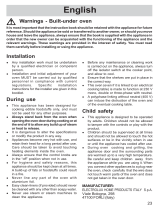Zanussi ZOB893QA is a built-in electric oven with a range of functions to help you cook delicious meals. It features conventional cooking, top and bottom heating elements, a grill, and a fan cooking option for even heat distribution. The oven also includes a defrost setting, a minute minder, and an electronic programmer with cooking duration and end of cooking time settings. Additionally, the oven has a safety thermostat to prevent overheating and a cooling fan to keep the front panel, knobs, and door handle cool.
Zanussi ZOB893QA is a built-in electric oven with a range of functions to help you cook delicious meals. It features conventional cooking, top and bottom heating elements, a grill, and a fan cooking option for even heat distribution. The oven also includes a defrost setting, a minute minder, and an electronic programmer with cooking duration and end of cooking time settings. Additionally, the oven has a safety thermostat to prevent overheating and a cooling fan to keep the front panel, knobs, and door handle cool.




















-
 1
1
-
 2
2
-
 3
3
-
 4
4
-
 5
5
-
 6
6
-
 7
7
-
 8
8
-
 9
9
-
 10
10
-
 11
11
-
 12
12
-
 13
13
-
 14
14
-
 15
15
-
 16
16
-
 17
17
-
 18
18
-
 19
19
-
 20
20
-
 21
21
-
 22
22
-
 23
23
Zanussi ZOB893QA User manual
- Type
- User manual
Zanussi ZOB893QA is a built-in electric oven with a range of functions to help you cook delicious meals. It features conventional cooking, top and bottom heating elements, a grill, and a fan cooking option for even heat distribution. The oven also includes a defrost setting, a minute minder, and an electronic programmer with cooking duration and end of cooking time settings. Additionally, the oven has a safety thermostat to prevent overheating and a cooling fan to keep the front panel, knobs, and door handle cool.
Ask a question and I''ll find the answer in the document
Finding information in a document is now easier with AI
Related papers
-
Zanussi ZOB892QX User manual
-
Zanussi ZBM763X User manual
-
Zanussi ZOB892X User manual
-
Zanussi ZOU799QW User manual
-
Zanussi ZOB316ST User manual
-
Zanussi BMX316 User manual
-
Zanussi ZOU893QX User manual
-
 Zanussi Electrolux Built-in oven User manual
Zanussi Electrolux Built-in oven User manual
-
Zanussi ZOU884B User manual
-
Zanussi ZOB899WS User manual
Other documents
-
Electrolux EOB6711X User manual
-
Electrolux EOB6711X User manual
-
Electrolux EON6701X User manual
-
Electrolux EON6701X User manual
-
Electrolux EOB3711W User manual
-
Electrolux EOB1711X User manual
-
Electrolux EOB9710X User manual
-
Electrolux EOB9710X User manual
-
Electrolux EOB53003X User manual
-
Electrolux EOB31002X User manual























